Go to Optimal Value vs. OFC
Optimal Value vs. RHS
Main principles:
- A dual price is associated with each constraint.
- The dual price measures the improvement
in the objective function (OV) per unit of increase
in the RHS.
- Improvement in a Max problem means
increase in OV, while in a Min
problem it means decrease in OV.
- Increasing the RHS of a "<=" type loosens the constraint and
vice versa.
- Increasing the RHS of a ">=" type tightens the constraint
and vice versa.
- Tightening the constraint can not improve the OV.
- Loosening a constraint cannot hurt the OV.
- An inactive constraint cannot become active by loosening.
- The dual price of an inactive constraint is zero.
- Generally, the dual price of an active "<=" constraint is
positive, while that of ">=" type is negative.
- The dual price of an "=" constraint can be positive or
negative.
- An inactive "<= (>=)" type constraint can be tightened by
the amount of slack (surplus).
- Within the allowable range of RHS the solution and the OV may
change but the dual price will remain constant.
- When the change in the RHS is outside the allowable range
the dual price may change in a way "to help less and less" or "to
hurt more and more."
Let's apply these principles to a number of scenarios: In what
follows b denotes the right hand side of a constraint, AI denotes
allowable increase, AD allowable decrease. 0 superscript denote
the current values of b and OV. The number in parentheses refer
to the principle above
Scennarios:
- Max <= active
- Max <= inactive
- Max >= active
- Max >= inactive
- Min <= active
- Min <= inactive
- Min >= active
- Max >= inactive
- Objective:Max Constraint: active
less-than-or-equal-to.
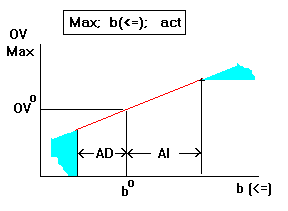 Here the dual price is >0. As the RHS (b) increases, the OV
improves (increases) at a rate equal to the dual price (2). The
dual price stays constant in the allowable interval (13). When
the change in b exceeds the AI the dual price may be reduced
(increasing the RHS is helping but after this point the rate of
improvement will be dampened). So, the OV will be somewhere in
the blue area on the right (14). Likewise if b is curtailed by
more than AD the dual price may get larger (reducing the RHS is
hurting but after the threshold is reached it will start hurting
even more.) The OV therefore will be somewhere in the blue area
on the left. (14) This relationship actually illustrates one of
the main laws of micro economic theory. Anybody remember what this
is? If you do, send me an e-mail
. go back
Here the dual price is >0. As the RHS (b) increases, the OV
improves (increases) at a rate equal to the dual price (2). The
dual price stays constant in the allowable interval (13). When
the change in b exceeds the AI the dual price may be reduced
(increasing the RHS is helping but after this point the rate of
improvement will be dampened). So, the OV will be somewhere in
the blue area on the right (14). Likewise if b is curtailed by
more than AD the dual price may get larger (reducing the RHS is
hurting but after the threshold is reached it will start hurting
even more.) The OV therefore will be somewhere in the blue area
on the left. (14) This relationship actually illustrates one of
the main laws of micro economic theory. Anybody remember what this
is? If you do, send me an e-mail
. go back
- Objective: Max Constraint
inactive less-than-or-equal-to.
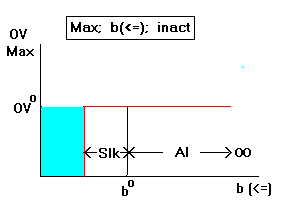 The dual price is zero (9) and the constraint can be
loosened indefinitely (8). The OV does not change until the
constraint is tightened by the amount of allowable decrease which
is equal to slack (Slk) (12). When this point is reached the
constraint becomes active and OV may start going down (blue area
on the left) (14). go back
The dual price is zero (9) and the constraint can be
loosened indefinitely (8). The OV does not change until the
constraint is tightened by the amount of allowable decrease which
is equal to slack (Slk) (12). When this point is reached the
constraint becomes active and OV may start going down (blue area
on the left) (14). go back
- Objective: Max; Constraint:
active greater-than-or-equal-to.
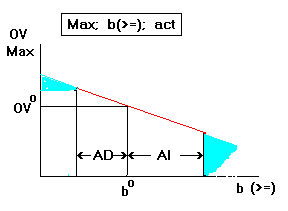 Increasing the RHS tightens the constraint (5) and reduces the OV
at the rate of the dual price (2). When upper end of the interval
is reached the dual price may decrease (become a larger negative
number) and begin to reduce the OV at even a faster rate (blue
area on the right) (14). When lower end is reached dual price may
become larger and help the OV at a dampened rate (blue area on
the left) (14). go back
Increasing the RHS tightens the constraint (5) and reduces the OV
at the rate of the dual price (2). When upper end of the interval
is reached the dual price may decrease (become a larger negative
number) and begin to reduce the OV at even a faster rate (blue
area on the right) (14). When lower end is reached dual price may
become larger and help the OV at a dampened rate (blue area on
the left) (14). go back
- Objective: Max; Constraint:
inactive greater-than-or-equal-to.
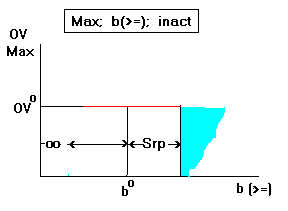 The RHS can be made arbitrarily small (8) and can be tightened by
as much as the amount of surplus (Srp) (12). When that happens
the constraint will become active and any further tightening will
make the dual price negative (10) and hence cause a drop in the
OV (blue area on the right) (14). go back
The RHS can be made arbitrarily small (8) and can be tightened by
as much as the amount of surplus (Srp) (12). When that happens
the constraint will become active and any further tightening will
make the dual price negative (10) and hence cause a drop in the
OV (blue area on the right) (14). go back
- Objective:Min Constraint: active
less-than-or-equal-to.
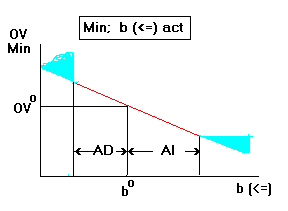 As a "<=" type active constraint is loosened (increase the RHS)
the objective improves (7) --goes down in minimization. Since a
positive change is associated with positive improvement in the OV
the dual price is positive (2). If the increase in the RHS
exceeds the allowable increase the rate of improvement will be
dampened (blue area on the right) (14). If the RHS is tightened
beyond the allowable decrease, the rate of deterioration may be
higher (blue area on the left) (14) go back
As a "<=" type active constraint is loosened (increase the RHS)
the objective improves (7) --goes down in minimization. Since a
positive change is associated with positive improvement in the OV
the dual price is positive (2). If the increase in the RHS
exceeds the allowable increase the rate of improvement will be
dampened (blue area on the right) (14). If the RHS is tightened
beyond the allowable decrease, the rate of deterioration may be
higher (blue area on the left) (14) go back
- Objective:Min Constraint: inactive
less-than-or-equal-to.
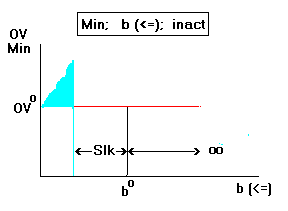 Dual price is zero (9); it will remain zero no matter by how much
the constraint is loosened (RHS increased) (8). It can however be
tightened by the amount of slack (Slk) (12). When that happens
the dual price will become positive (10) and any further
reduction in the RHS will be associated with deterioration of the
OV (blue area on the right) (14). go back
Dual price is zero (9); it will remain zero no matter by how much
the constraint is loosened (RHS increased) (8). It can however be
tightened by the amount of slack (Slk) (12). When that happens
the dual price will become positive (10) and any further
reduction in the RHS will be associated with deterioration of the
OV (blue area on the right) (14). go back
- Objective:Min Constraint: active
greater-than-or-equal-to.
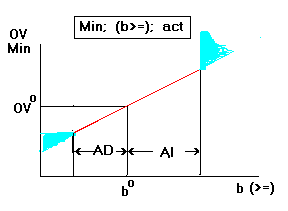 Increasing the RHS tightens the constraint (5) and causes a
negative improvement (increase) in the OV (6). If it is tightened
beyond AI the rate of increase in the OV will be higher (blue
area on the right). If it is loosened by more than AD, the OV
will decline (helped) at a slower rate (blue area on the
right)(14). go back
Increasing the RHS tightens the constraint (5) and causes a
negative improvement (increase) in the OV (6). If it is tightened
beyond AI the rate of increase in the OV will be higher (blue
area on the right). If it is loosened by more than AD, the OV
will decline (helped) at a slower rate (blue area on the
right)(14). go back
- Objective:Min Constraint: inactive
greater-than-or-equal-to.
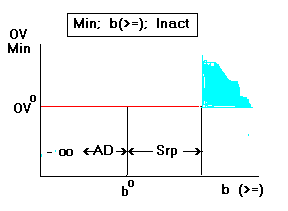 The constraint can be loosened without limit (8), it can be
tightened by the amount of the surplus (Srp) (12). If it is
tightened beyond that, it will become active, the dual price will
become negative (10) and further tightening (increase in RHS)
will force an increase (negative improvement) in the OV (6). go back
The constraint can be loosened without limit (8), it can be
tightened by the amount of the surplus (Srp) (12). If it is
tightened beyond that, it will become active, the dual price will
become negative (10) and further tightening (increase in RHS)
will force an increase (negative improvement) in the OV (6). go back
 Here the dual price is >0. As the RHS (b) increases, the OV
improves (increases) at a rate equal to the dual price (2). The
dual price stays constant in the allowable interval (13). When
the change in b exceeds the AI the dual price may be reduced
(increasing the RHS is helping but after this point the rate of
improvement will be dampened). So, the OV will be somewhere in
the blue area on the right (14). Likewise if b is curtailed by
more than AD the dual price may get larger (reducing the RHS is
hurting but after the threshold is reached it will start hurting
even more.) The OV therefore will be somewhere in the blue area
on the left. (14) This relationship actually illustrates one of
the main laws of micro economic theory. Anybody remember what this
is? If you do, send me an e-mail
. go back
Here the dual price is >0. As the RHS (b) increases, the OV
improves (increases) at a rate equal to the dual price (2). The
dual price stays constant in the allowable interval (13). When
the change in b exceeds the AI the dual price may be reduced
(increasing the RHS is helping but after this point the rate of
improvement will be dampened). So, the OV will be somewhere in
the blue area on the right (14). Likewise if b is curtailed by
more than AD the dual price may get larger (reducing the RHS is
hurting but after the threshold is reached it will start hurting
even more.) The OV therefore will be somewhere in the blue area
on the left. (14) This relationship actually illustrates one of
the main laws of micro economic theory. Anybody remember what this
is? If you do, send me an e-mail
. go back  The dual price is zero (9) and the constraint can be
loosened indefinitely (8). The OV does not change until the
constraint is tightened by the amount of allowable decrease which
is equal to slack (Slk) (12). When this point is reached the
constraint becomes active and OV may start going down (blue area
on the left) (14). go back
The dual price is zero (9) and the constraint can be
loosened indefinitely (8). The OV does not change until the
constraint is tightened by the amount of allowable decrease which
is equal to slack (Slk) (12). When this point is reached the
constraint becomes active and OV may start going down (blue area
on the left) (14). go back  Increasing the RHS tightens the constraint (5) and reduces the OV
at the rate of the dual price (2). When upper end of the interval
is reached the dual price may decrease (become a larger negative
number) and begin to reduce the OV at even a faster rate (blue
area on the right) (14). When lower end is reached dual price may
become larger and help the OV at a dampened rate (blue area on
the left) (14). go back
Increasing the RHS tightens the constraint (5) and reduces the OV
at the rate of the dual price (2). When upper end of the interval
is reached the dual price may decrease (become a larger negative
number) and begin to reduce the OV at even a faster rate (blue
area on the right) (14). When lower end is reached dual price may
become larger and help the OV at a dampened rate (blue area on
the left) (14). go back  The RHS can be made arbitrarily small (8) and can be tightened by
as much as the amount of surplus (Srp) (12). When that happens
the constraint will become active and any further tightening will
make the dual price negative (10) and hence cause a drop in the
OV (blue area on the right) (14). go back
The RHS can be made arbitrarily small (8) and can be tightened by
as much as the amount of surplus (Srp) (12). When that happens
the constraint will become active and any further tightening will
make the dual price negative (10) and hence cause a drop in the
OV (blue area on the right) (14). go back
 As a "<=" type active constraint is loosened (increase the RHS)
the objective improves (7) --goes down in minimization. Since a
positive change is associated with positive improvement in the OV
the dual price is positive (2). If the increase in the RHS
exceeds the allowable increase the rate of improvement will be
dampened (blue area on the right) (14). If the RHS is tightened
beyond the allowable decrease, the rate of deterioration may be
higher (blue area on the left) (14) go back
As a "<=" type active constraint is loosened (increase the RHS)
the objective improves (7) --goes down in minimization. Since a
positive change is associated with positive improvement in the OV
the dual price is positive (2). If the increase in the RHS
exceeds the allowable increase the rate of improvement will be
dampened (blue area on the right) (14). If the RHS is tightened
beyond the allowable decrease, the rate of deterioration may be
higher (blue area on the left) (14) go back
 Dual price is zero (9); it will remain zero no matter by how much
the constraint is loosened (RHS increased) (8). It can however be
tightened by the amount of slack (Slk) (12). When that happens
the dual price will become positive (10) and any further
reduction in the RHS will be associated with deterioration of the
OV (blue area on the right) (14). go back
Dual price is zero (9); it will remain zero no matter by how much
the constraint is loosened (RHS increased) (8). It can however be
tightened by the amount of slack (Slk) (12). When that happens
the dual price will become positive (10) and any further
reduction in the RHS will be associated with deterioration of the
OV (blue area on the right) (14). go back
 Increasing the RHS tightens the constraint (5) and causes a
negative improvement (increase) in the OV (6). If it is tightened
beyond AI the rate of increase in the OV will be higher (blue
area on the right). If it is loosened by more than AD, the OV
will decline (helped) at a slower rate (blue area on the
right)(14). go back
Increasing the RHS tightens the constraint (5) and causes a
negative improvement (increase) in the OV (6). If it is tightened
beyond AI the rate of increase in the OV will be higher (blue
area on the right). If it is loosened by more than AD, the OV
will decline (helped) at a slower rate (blue area on the
right)(14). go back  The constraint can be loosened without limit (8), it can be
tightened by the amount of the surplus (Srp) (12). If it is
tightened beyond that, it will become active, the dual price will
become negative (10) and further tightening (increase in RHS)
will force an increase (negative improvement) in the OV (6). go back
The constraint can be loosened without limit (8), it can be
tightened by the amount of the surplus (Srp) (12). If it is
tightened beyond that, it will become active, the dual price will
become negative (10) and further tightening (increase in RHS)
will force an increase (negative improvement) in the OV (6). go back